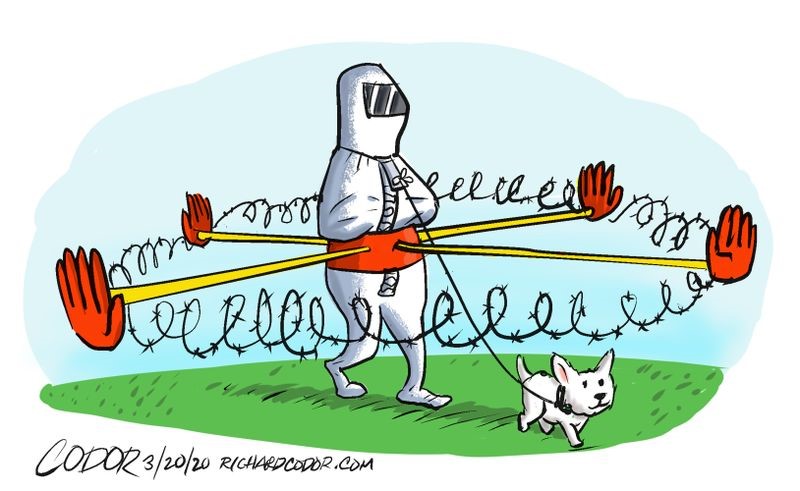Like most of you, I never thought we’d be here. And by here, I mean… home… quarantined and unsure of when this all will end. Over and over again we hear the words, “new normal”, but it certainly doesn’t feel normal to me yet.
Still, it is becoming increasingly clear how many of our dogs are benefiting from this Covid 19 pandemic. Suddenly us humans are home all the time, and in our desperate need to get out of the house, taking more frequent and often longer walks, and spending more time playing in the yard.
The other big benefit is that social distancing is making people so much more respectful of boundaries. When out walking, the new protocol seems to be to switch to the other side of the road if you see someone coming up ahead. Many of us dog owners may already do this, but now it seems like an unspoken mandate from the walking police. Suddenly, you no longer need to dodge that unruly dog on a 15 foot retractable leash or avoid the friendly neighbors who want to grab and squeeze your dog’s face because, “he’s just soooo cute!” despite your many attempts to tell the person, “please stop, my dog is uncomfortable.” Is it just me or have walks with the dog just become so much more pleasant?

I’m sure many dogs are feeling the same way! We talk about social distancing now as a way to avoid infection, but we could just as easily argue that all of us, dogs included, have a social distance we are all comfortable with. I’m sure many of you are familiar with the Seinfeld episode featuring “the close talker.” If not, see the clip below:
I think it’s fair to say that most of the characters were quite uncomfortable with how close Elaine’s boyfriend, Aaron, got to them when speaking. You might even cringe just watching it, imagining your own discomfort in that scenario. Notice, however, that Elaine seemed less bothered by the distance and Jerry’s parents, after spending a whole wonderful afternoon with Aaron, were likely also less bothered by it in the end. Why? Your comfort level with a person can change your social distance.
With dogs, it works the same way. They might be happy to cuddle up to your family or to the other family dog but need a far greater distance when it comes to strange humans or unfamiliar dogs. We often consider dogs to be “unfriendly” or “reactive” when they struggle with close distances, but perhaps we just need to view them as having a greater need for social distance than other dogs. By determining your dog’s social distance, you can help them cope with the world around them, and you have a way to measure your progress if you are working on your dog’s reactivity around other dogs.
Right now, your dog may bark, lunge, and growl at dogs across the street from you when you are out walking. Their social distance is clearly not being met in this scenario. To determine their social distance, you may need to go to a park where you can get a much larger distance away from the road or path where dogs are walking by in order to determine at what distance your dog is most comfortable with strange dogs moving past. It is at THAT distance where your training begins.
From there, you work on making your dog comfortable with dogs moving past. By using a system of desensitization and counter conditioning (your trainer can help you with this), we can reframe your dog’s brain to react to strange dogs more like Elaine or Jerry’s parents and less like Kramer. As your dog’s comfort increases, the distance can be reduced.
That being said, almost nobody’s social distance with a stranger is zero. It would be unreasonable to expect a dog with a large social distance now to one day want to buddy up to every dog or human they meet. After all, even before the corona virus, I don’t imagine you went around hugging every stranger you met in an elevator. We do need to keep our goals realistic, but the point is that there is hope! And with all the dogs out and about right now, you have a lot of opportunities to practice good social distance, especially now that humans are more aware of the need than ever.
For help with reactivity in dogs, reach out to your trainer and check out the resources linked below:
-Helping Fearful Dogs
-Care for Reactive Dogs
I want to thank fellow dog trainer Linda Hobson for suggesting this month’s newsletter topic. She adds, her own dog Jed has a social distance of 3-5 feet around unknown dogs.
Happy Training!
Nicole Lorenzetti Yuhas CPDT-KA
This blog is intended to be informative as well as entertaining. It contains my opinion which may not reflect the opinions of any organization I may be affiliated with. My opinions should not be interpreted as those of my coworkers, family, friends, casual acquaintances, and certainly not the opinion of my cat, although my dog probably agrees with everything I say, if for no other reason, than because I provide the treats and meals (cats are less inclined to agree with anyone but themselves). Information provided here is accurate and true to the best of my knowledge but, as information and opinions change, neither the facts nor the opinions expressed here may be true or accurate at any future date. As I don’t currently own a time machine, I cannot be responsible for things that prove to be untrue, or opinions I change my mind about, should those changes become apparent in the future. It should also be noted that, as I am human, there may be omissions, errors or mistakes in the information provided here. Frankly, even if I were a computer, it is likely there would be errors, as computers, in my experience, can be a royal pain in the butt. This blog may contain affiliate links which you are under no obligation to click. If you click them, they will hopefully take you the place I intended. But they may not. As I’ve said, computers can be a pain. If you find yourself somewhere you don’t think I intended, click your ruby slippers three times together and say, “there is no place like home.” If you do that, and click the “back” button, you should be safely returned. Computers can, at times, have a mind of their own. Any training suggestions or opinions expressed here should be taken as information only and should not be seen as advice particular to you or your dog’s unique situation. Please consult with a training professional before taking any action.
